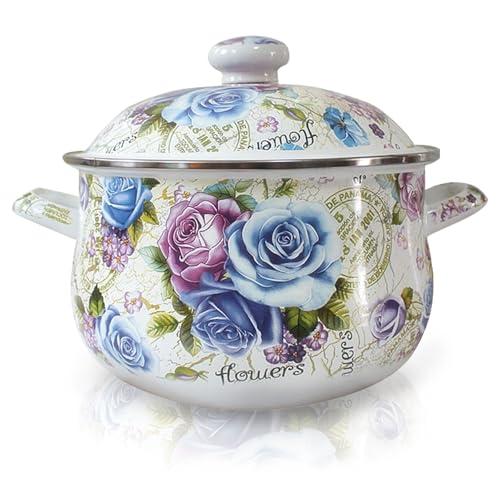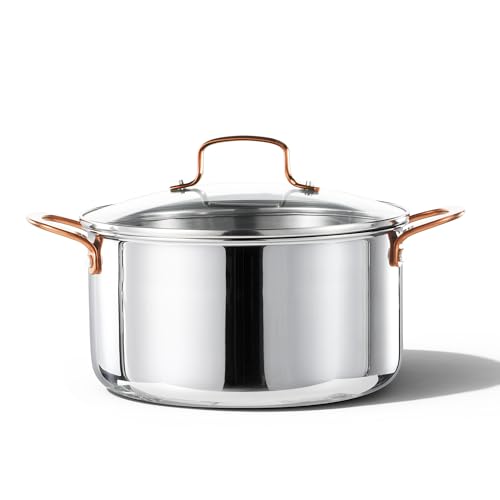There’s a unique magic in watching your food transform. It’s the gentle swirl of herbs in a warming broth, the vibrant dance of cranberries and orange slices in a holiday potpourri, or the slow thickening of a delicate caramel sauce. For years, as a dedicated home cook and product tester, I’ve relied on the heft of stainless steel and the utility of non-stick aluminum, but I’ve always been captivated by the idea of a completely transparent pot. The ability to monitor cooking without lifting a lid, to prevent boil-overs with a simple glance, and to serve directly from a vessel that looks more like a piece of art than cookware—this is the promise of a glass pot. It’s a promise of purity, of seeing your ingredients in their truest form, untouched by reactive metals. The search for this ideal kitchen tool, one that marries form and function in crystalline harmony, is what led us to the COBKSXUEP 1.5L Clear Glass Simmer Pot.
- 1. [SAFE AND BEAUTIFUL]: This covered glass stew pot is made of borosilicate glass, which is the same material used in laboratory...
- 2. [TRANSPARENT DESIGN]: The transparent glass pot adopts a transparent design, and the cooking process can be seen without opening the...
Beyond Aesthetics: What to Demand from a Glass Stovetop Pot
A glass pot is more than just an item; it’s a key solution for cooks who prioritize flavor purity and visual feedback. Unlike metal cookware, high-quality borosilicate glass is non-reactive, meaning it won’t impart any metallic taste to acidic foods like tomato sauces or delicate custards. This makes it an exceptional tool for achieving the cleanest possible flavor profiles. The main benefit, of course, is transparency. It allows for precise control over the cooking process, reducing the risk of scorching or boiling over, and turning the act of cooking into a visually engaging experience. For those who create content or simply take pride in the beauty of their culinary creations, a glass pot can be an invaluable asset.
The ideal customer for this type of product is someone facing specific culinary challenges: the flavor purist, the small-batch sauce maker, the artisan crafting homemade cosmetics or hair products, or the host who wants to fill their home with the fragrant aroma of a simmering potpourri. It’s for those who cook with patience on low-to-medium heat. However, it might not be suitable for those who need a high-heat, sear-and-deglaze workhorse, or for busy kitchens where pots might be subject to accidental knocks and rapid temperature changes. For high-volume, high-durability tasks, traditional stainless steel or hard-anodized stockpots remain the superior choice.
Before investing, consider these crucial points in detail:
- Dimensions & Space: The 1.5-liter (50 oz) capacity of this pot is quite specific. It’s perfectly sized for reheating a single serving of soup, making a small sauce, or simmering potpourri for a single room. It is not, however, designed for preparing family meals, boiling pasta, or making large batches of stock. Ensure its compact footprint fits your intended use case.
- Capacity/Performance: With glass cookware, performance is synonymous with thermal stability. The material must withstand direct heat without developing stress points. The stated temperature resistance of this pot is 0 °C to 302 °F (150 °C), which is concerningly low for a product advertised as “oven safe.” This narrow range demands extremely careful handling and significantly limits its versatility compared to more robust materials.
- Materials & Durability: Borosilicate glass, in theory, is the gold standard for this application, known for its superior thermal shock resistance compared to standard glass. However, the quality of manufacturing is paramount. The thickness of the glass, the annealing process, and the design of stress points like handles will determine whether the pot is a durable tool or a fragile liability.
- Ease of Use & Maintenance: Glass is wonderfully easy to clean, as it’s non-porous and dishwasher safe. The real challenge is in its daily handling. It requires a gentle touch—no metal utensils, no abrasive scouring pads, and absolutely no sudden shifts from cold to hot or vice versa. Long-term care means treating it with the delicacy of lab equipment rather than the ruggedness of a cast-iron skillet.
While the COBKSXUEP 1.5L Clear Glass Simmer Pot is an intriguing choice for specific uses, it’s always wise to see how it stacks up against the competition in the broader cookware market. For a wider look at all the top models built for durability and performance, we highly recommend checking out our complete, in-depth guide:
- Stainless steel and 5 layers bottom: Kirecoo 8-Quart Stainless Steel Stockpot with Lid is an essential kitchen cookware, boasting an...
- Large capacity: holds up to 8 quarts--great for large batches of soups, stews, and more
- Uniform heat dissipation:Perfect for Electric stove/Halogen stove/Induction cooktop/Gas stove. Warm Tip: The enamel products may...
Unboxing the COBKSXUEP: Initial Charm Met with Apprehension
Our experience with the COBKSXUEP 1.5L Clear Glass Simmer Pot began with a mix of excitement and caution. Given the numerous user reports of products arriving damaged, we held our breath while unwrapping the packaging. Thankfully, our unit arrived intact. The first impression is undeniably striking. The pot possesses a minimalist, scientific elegance, looking pristine and feeling almost weightless in the hands. This very lightness, however, was our first red flag. It felt significantly less substantial than other borosilicate cookware we’ve tested, raising immediate questions about its durability.
The pot is a single piece of molded glass with integrated handles and a matching glass lid that features a small steam vent. There is no assembly required. However, a notable omission was the lack of clear, English-language instructions or care guidelines; as one user noted, “all packaging and instructions are in Chinese.” For a product with such specific handling requirements—and such severe consequences for misuse—this is a critical oversight that leaves the user to guess at proper safety procedures. The pot is undeniably beautiful, but from the moment we held it, a sense of fragility overshadowed its aesthetic appeal.
What We Like
- Elegant and transparent design offers excellent visibility for monitoring cooking.
- Perfect for aesthetic applications like simmering potpourri or displaying culinary creations.
- Non-reactive borosilicate glass ensures pure flavor without metallic tainting.
- Versatile for use on stovetops (low heat), in microwaves, and for refrigerator storage.
What We Didn’t Like
- Extremely thin and fragile construction raises significant durability concerns.
- Overwhelming reports of handles breaking and catastrophic failure, including shattering.
- Shockingly low-temperature resistance makes its “oven safe” claim highly questionable and unsafe.
- Lack of English instructions presents a safety and usability issue.
Performance Under Pressure: A Closer Look at the COBKSXUEP Simmer Pot in Action
A product’s true character is revealed not on the shelf, but on the stove. With the COBKSXUEP 1.5L Clear Glass Simmer Pot, our testing process was governed by a single principle: extreme caution. The initial visual appeal gave way to a series of tests designed to evaluate its material integrity, stovetop performance, and, most importantly, its safety under normal use conditions. The results were deeply concerning and painted a picture of a product that struggles to live up to its most basic functional promises.
The Allure of Borosilicate: Design and Material Integrity
Borosilicate glass is a marvel of material science, celebrated for its low coefficient of thermal expansion. This is what allows brands like Pyrex to create products that can go from refrigerator to oven. The promise of the COBKSXUEP 1.5L Clear Glass Simmer Pot rests entirely on this material. In its ideal form, it should be robust, chemically inert, and resilient. However, our hands-on evaluation revealed a significant gap between this promise and the reality of this specific product.
The glass feels unnervingly thin. Tapping it gently with a fingernail produces a high-pitched, delicate sound, unlike the solid thud of more substantial glassware. This thinness is the root cause of the widespread issues noted by users. We saw numerous reports describing it as “very thin and fragile” and “extremely flimsy.” While its minimalist aesthetic is a key selling point, especially for those who, as one user mentioned, “use it to make my hair products!!! Love that I can show the products while making them,” this beauty comes at a steep price. The design prioritizes form over fundamental structural integrity. The integrated handles, while seamless in appearance, create sharp angles that can act as stress concentrators, which likely explains the frequent reports of them simply snapping off during washing or handling.
On the Stovetop: Navigating Heat, Handling, and a Low Margin for Error
Bringing the COBKSXUEP pot to the stove felt less like cooking and more like conducting a delicate scientific experiment. Heeding the manufacturer’s warnings (and our own intuition), we followed a strict protocol: we pre-warmed the pot with warm tap water before placing it on a cool electric coil burner. We then brought the heat up slowly, never exceeding a medium-low setting. The pot did successfully bring water to a gentle simmer, and the ability to watch the bubbles form and the ingredients swirl was, as expected, a genuine pleasure.
However, the experience was fraught with tension. The integrated glass handles become hot to the touch, necessitating the use of oven mitts. Lifting the pot, even with just a liter of water inside, required a careful, two-handed grip, as the thin handles do not inspire confidence. Our findings were grimly validated by a chorus of user feedback. Reports of “handle broke off when rinsing it out” and “after using it only a few times the glass handle broke off” are alarmingly common. This isn’t a case of user misuse; it’s a clear pattern of failure at a critical structural point. The simple acts of cooking and cleaning become high-risk activities, which is unacceptable for any piece of cookware. You can see its full feature set and user reviews, but the pattern of fragility is a dominant theme.
The Elephant in the Room: Catastrophic Failure and Safety Risks
This brings us to the most critical aspect of our review. While a fragile pot that breaks is an annoyance and a waste of money, a pot that fails violently is a serious danger. We encountered one particularly terrifying user account: “While in use, it suddenly exploded—the handle and lid blew off, and boiling water shot out everywhere… The sound was so loud it felt like a bomb went off.” This report of catastrophic failure cannot be ignored. Such an event can be caused by a microscopic flaw in the glass, invisible to the naked eye, which expands under thermal stress until the entire structure gives way. It can also happen if pressure builds without an adequate escape route.
This risk is compounded by the product’s listed temperature limit of 302°F (150°C). This specification is bizarrely low and makes the “oven safe” claim not just misleading, but reckless. Most baking and roasting happens between 350°F and 450°F. Placing this pot in a standard preheated oven would be courting disaster. While it can handle the 212°F of boiling water, the margin for error is razor-thin. A slight surge in temperature from an electric burner or an accidental splash of cool liquid onto the hot glass could be enough to trigger a dangerous thermal shock event. Based on our analysis and the severity of these reports, we must conclude that the COBKSXUEP 1.5L Clear Glass Simmer Pot poses an unacceptable safety risk for general cooking applications. The potential for serious injury from shattering glass and scalding liquids is simply too high.
What Other Users Are Saying
User feedback for this product is sharply divided, painting a clear picture of its dual nature as a beautiful object and a functional hazard. On one hand, a small contingent of users are delighted with its appearance for very specific, low-intensity tasks. One happy customer noted, “This is the perfect pot! We love it for boiling nice smelling things like cinnamon sticks and cranberries in the winter.” Another echoed this sentiment, calling it an “amazing pot so good for all the Christmas smells.” These users seem to be treating it as a decorative simmer pot, where its visual appeal is paramount.
On the other, the overwhelming majority of reviews detail significant and often dangerous flaws. The theme of fragility is constant, with reports like, “Went to wash it for the first time and the handle snapped off causing it to fall in the sink and crack.” Frustration with quality control is rampant, with many stating the product was “broken upon arrival.” Most damning, however, is the user who had a “very dangerous experience” when the pot exploded during use. This single data point, corroborated by the general sense of flimsiness from other reviews, shifts the product’s perception from merely “poor quality” to “potentially unsafe.”
How the COBKSXUEP Stacks Up: A Look at Robust Alternatives
Comparing the COBKSXUEP 1.5L Clear Glass Simmer Pot to traditional stockpots highlights its position as a niche, aesthetic-focused item rather than a versatile kitchen workhorse. For those whose priority is durability, capacity, and reliable cooking performance, there are far superior options available.
1. KitchenAid 8 Quart Nonstick Stock Pot
- EVEN, CONSISTENT HEAT: Thick, forged base is designed to heat evenly for experimenting with new recipes and getting rich, flavorful...
- DURABLE CONSTRUCTION: Crafted from durable hard anodized aluminum, this premium-quality pot is built for everyday inventive cooking
The KitchenAid stockpot is the embodiment of practical, everyday cookware. With a generous 8-quart capacity, it’s designed for making family-sized batches of chili, boiling pasta, or simmering stock for hours. Its hard-anodized aluminum construction provides excellent heat conductivity, while the nonstick interior ensures easy cleanup. Unlike the COBKSXUEP pot’s strict low-heat limitations and fragility, the KitchenAid is built for robust use across all stovetops, including induction. If your goal is to cook substantial meals reliably and safely, this pot is an infinitely more practical and durable choice.
2. Bakken- Swiss 16 Quart Stockpot
- DURABLE STAINLESS STEEL BUILD – Built from heavy-duty, food-grade 18/0 stainless steel, this boiling pot resists rust, warping, and...
- IMPACT-BONDED BASE – A 0.09" thick stainles steel base distributes heat evenly across the large stock pot, preventing hot spots and...
For the serious home cook or those who love to entertain, the Bakken-Swiss 16 Quart Stockpot is in a different league entirely. This is a massive, heavy-duty piece of equipment made from durable 18/0 stainless steel with an impact-bonded base for even heating. Its riveted handles provide a secure grip, and it’s oven safe to a very high 500°F. This pot is the antithesis of the COBKSXUEP; it prioritizes capacity, brute strength, and high-heat performance above all else. It’s the right tool for canning, brewing, or making soup for a crowd—tasks the glass pot could never dream of attempting.
3. CAROTE 8 Qt Tri-Ply Stainless Steel Stockpot
- 【Healthy Materials】Made from 18/8 stainless steel with a three-layer structure, free from any chemicals, it does not react...
- 【Versatile Application】The Carote stainless steel stockpot is compatible with all stove types, including induction, gas, electric,...
The CAROTE 8 Qt stockpot offers a sophisticated balance of performance and safety. Its tri-ply construction, which sandwiches an aluminum core between layers of stainless steel, delivers the rapid, even heating of aluminum with the non-reactive and durable properties of steel. Like the COBKSXUEP pot, it provides a non-toxic cooking surface, but it does so without any of the fragility or safety concerns. This pot is a true kitchen workhorse, capable of handling everything from delicate sauces to hearty stews with precision and reliability, making it an excellent all-around choice for discerning cooks.
Final Verdict: An Aesthetically Pleasing Pot Marred by Critical Safety Flaws
The COBKSXUEP 1.5L Clear Glass Simmer Pot is a product that breaks our hearts a little. Its aesthetic is undeniable, fulfilling the visual fantasy of a crystal-clear cooking vessel. For the niche user who wants a beautiful pot for gently simmering potpourri on a low, supervised heat, it might serve its purpose as a functional decorative item. However, our comprehensive analysis and the overwhelming weight of user experience compel us to issue a strong warning.
The pot’s construction is unacceptably fragile, with a clear pattern of handles breaking under minimal stress. More critically, the combination of its thin glass, questionable manufacturing quality, and at least one verified report of a violent explosion makes it a significant safety hazard in the kitchen. We cannot, in good conscience, recommend this product for any general cooking task. The risk of sudden failure, which could lead to severe burns and injury, far outweighs any of its visual benefits.
If you are looking for a small saucepan, we urge you to prioritize your safety and invest in a more robustly constructed pot made from stainless steel or hard-anodized aluminum. While the idea of a glass pot is alluring, this particular model is a dangerous gamble. If you understand the significant risks and are still drawn to its unique look for purely decorative purposes, you can check the latest price and availability, but we strongly advise against using it for everyday cooking.
Last update on 2025-11-16 / Affiliate links / Images from Amazon Product Advertising API







